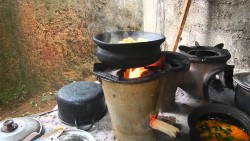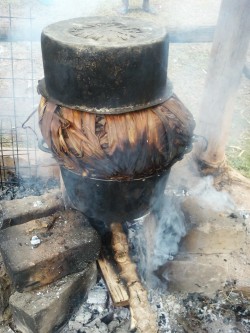
Fire is one of the earth’s four cardinal elements and mythology is filled with stories of how mankind got their hands on it in the first place. We do know that being able to make fire changed the face of nutrition, health and human progress forever – and, whether you’re getting together for a barbecue or going camping, mankind is still making use of fire to prepare food thousands of years later. Here are some practical tips for cooking with fire…
Wood for Cooking
Some woods are poisonous themselves or release poisonous substances when burned, thus they are not suited to be used for firewood. These include poison sumac, blue gum, mimosa, oleander, palm, poplar and a wide variety of others. Could you tell the difference?
There are many great apps (and plenty excellent old-fashioned books) that can help you identify the type of wood you’re dealing with. Take a look at The Wood Database, the I.D. Wood app and Easy Wood Guide Pro. The Wood Database also has a list of poisonous woods you can refer to. Use only wood you can identify and know for sure is safe.
Boiling Water: A New Trick
Water can be boiled on a fire – that much should be obvious – though most people don’t know that you can boil water in a plastic cup, bottle or bag over a fire, too. This should only be done in an emergency where nothing else is available. Simply, it works because the water absorbs the heat that would otherwise have melted the plastic.
Timing
Preparing several dishes at once over a fire requires some thought over what goes on first and then after: The temperature will vary, and you don’t want some things burned while other things are coming off of the fire “under-done”.
Seasoning
Seasoning can and should always be kept simple and natural. Most dishes are only in need of salt, sugar, pepper and/or herbs – no more, no less. Even recipes that seem complex tend to come back to the most basic types of seasoning. Make sure that you always have salt as part of your survival kit – its uses will extend far beyond its use in cooking as salt is one of the cleanest substances around.
Starting a Fire
There are many ways to pack a fire, though keep in mind that heat distribution should be even and there should be nothing – and we mean nothing – that can catch fire near the flames. This includes around and above your fire, too. For safety, pack a formation of rocks or bricks around your fire before you light it. For very obvious reasons, you don’t want to make a fire indoors or in an enclosed space.
Related: How To Make A Fire Last All Night
Your kit should always contain firelighters and a fire-starter kit; you can also learn how to make a fire the old-fashioned way: Friction. Again, there are many demonstrations on YouTube to show you how. (For the record, Tom Hanks’ fire-starting skills in Cast Away were spot on.)
Safety and Extinguishing Fires
Always find out what your local laws say about making fire – in some cases you might have to apply for a

permit or let the authorities know ahead of time to avoid any hiccups. Fire safety means using common sense and making sure there’s nothing in the path of the flames – including objects, people, flammable materials and shelters; it also means cleaning up after yourself properly when you’re done. Make sure the fire is properly extinguished before leaving it behind.
If you need to extinguish a fire in an emergency, remember that to do this you’ve got to remove its source of oxygen – flour, maize and carbon-dioxide-based fire extinguishers are some ways; remember that you don’t want to throw water on an oil fire, either.
In Embers
While your other dishes are going on the fire, you can also prepare some of your food in the fire. Wrapped in aluminium foil, things like potatoes and sweet potatoes are perfect. Just be careful when placing them in and removing them from the embers.
Food Safety
Keep basic food safety in mind, too: Underdone chicken and pork are dangerous; always sterilize your hands and your equipment (especially to avoid cross-contamination between, for example, vegetables and raw chicken); be careful when working with sharp knives and hot implements, and be especially careful when working with fire. Also keep potential allergens (peanuts, eggs, milk, gluten, etc.) in mind, and be aware of the potential of cross-contamination there, too.
Do you have any fire-related cooking tips to share? Let us know about them in the comments!
3 comments
Choose your rocks wisely!
There’s two main things that generally cause this, the first being the moisture content in the rock and the second being the type of rock. If the rock is wet and you heat it rapidly, any water will turn to steam and put pressure on the rock, forcing shards of it to break off rapidly. Secondly the type of rock matters, layered rocks such as sandstone are much more likely to split and perhaps explode because of the weaker bonds between their layers. As pointed out below, watch out for very smooth rocks – a sign that they may have been on a river bed at some point in their lives and therefore have water trapped deep in them.
Pretty good article! The only things I would add is that you can, in a damp environment use small logs (not twigs) stacked up between braces in a semi-circle to make a heat reflector that also serves to help dry that wood to use on that fire thus getting more heat from that wood and reducing the amount of smoke produced. Obviously, if you’re going to sleep, you should move that reflector away from the fire! Also, a make-shift water-boiling container can be made from aluminum foil. Simply form a sheet of foil around your fist (or any open-ended container, etc.) leaving a few inches on the top rim on opposing sides to make it easy to remove from the fire. Let your fire burn down to coals before placing your water-filled foil container on it so it’s less likely to catch your foil on fire! GLAHP!
My favorite campfire meals are the foil packet meals we ate at my son’s Cub Scout camp. That training was awesome.